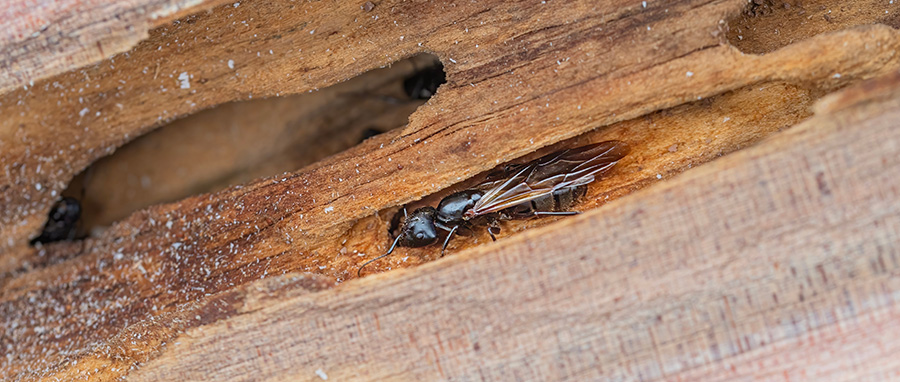A house is one of the most significant purchases that we will make in our lifetime, so when we find damage to our home, it can be frustrating, not to mention costly. Identifying the source of the loss and knowing how to eliminate it is essential to every homeowner.
In the United States, many threats can damage a home, including insects. These tiny creatures can destroy a home’s structure if left undealt for long periods.
One such vermin is the carpenter ant, with its sharp bite and tendency to nest inside of walls, their ability to cause structural damage is great. While only an ⅛ to ½ inch in size, these long black ants can cost more than you realize. Let’s look at what kind of damage carpenter ants can leave behind.
What Does Carpenter Ant Damage Look Like?
The damage they leave behind is often mistaken for termite damage as the properties are similar in appearance. The main difference is that the termites eat the wood, and carpenter ants burrow through it, living within the carved path they’ve created. They don’t often bite humans and are not venomous, so other than being a nuisance and eating the wood structure, you’re safe.
Carpenter ant damage typically occurs near places such as dishwashers, bathrooms, sinks, and laundry areas as they tend to favor moisture. If you’ve found carpenter ant damage in your home, here’s what to look out for:
- Wood Shavings and Frass: Check for sawdust-like material, known as “frass,” near wooden structures or openings. Carpenter ants create tunnels and leave behind wood shavings as they excavate.
- Hollow or Damaged Wood: Tap on wooden surfaces to identify hollowness or damage caused by carpenter ant tunneling. Weak or compromised wood structures may be visually apparent upon inspection.
- Presence of Ants: Keep an eye out for carpenter ants, especially during the active spring and summer months. Observing them inside your home, trailing along walls or windowsills, indicates an infestation.
- Cracks and Fractures: Look for cracks, fissures, or small openings in wooden beams, window frames, or door frames. Carpenter ants use these entry points to access and exit their nests.
- Sawdust Trails: Watch for sawdust trails along walls, floors, or surfaces near nesting sites. Carpenter ants discard frass outside their galleries, leaving visible trails.
7 Tips for Preventing Carpenter Ant Infestations
Preventing carpenter ant infestations requires a proactive approach to make your home less appealing to these wood-boring pests. Here are some practical tips to keep carpenter ants at bay:
- Eliminate Moisture Sources: Carpenter ants are attracted to moisture. Fix any leaks promptly, ensure proper ventilation in damp areas, and address any water accumulation around your home. Keep basements, bathrooms, and kitchens dry to discourage ant infestations.
- Seal Entry Points: Regularly inspect and seal any gaps, cracks, or openings in the foundation, walls, and around windows and doors. Carpenter ants can exploit even small entry points, so a thorough inspection is crucial.
- Trim Trees and Shrubs: Trim branches and vegetation that come into contact with your home. Carpenter ants often use overhanging branches as bridges to access your house. Keeping plants at a distance reduces the likelihood of ant entry.
- Store Firewood Away: Keep firewood, lumber, and other wooden materials stored away from your home and elevated from the ground. This helps prevent carpenter ants from establishing nests in these materials and subsequently migrating to your house.
- Inspect New Items: Before bringing in items like furniture, firewood, or outdoor equipment, inspect them for signs of carpenter ants. This precautionary measure prevents the unintentional introduction of ants into your living space.
- Regular Inspections: Conduct regular inspections of your home’s exterior and interior. Look for any early signs of carpenter ant activity, such as wood shavings, frass, or ants trailing along surfaces. Early detection allows for prompt intervention.
- Professional Pest Control: If you notice persistent signs of carpenter ants or want to take preventive measures, consider hiring a professional pest control service. They can assess your home, implement targeted treatments, and provide valuable advice on long-term prevention.
Are You Dealing With Carpenter Ants? We Can Help!
If you’ve spotted signs of carpenter ants or want to prevent an infestation, call Eden Advanced Pest Technologies today. Our expert team is ready to assist you in safeguarding your home from carpenter ant damage. Act now to ensure a pest-free environment – contact us today for a free in-home inspection.
Back to Ant Extermination – Control – Removal
